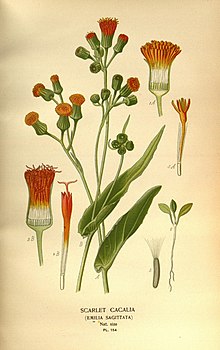Orange-red Emilie
| Orange-red Emilie | ||||||||||||
|---|---|---|---|---|---|---|---|---|---|---|---|---|

Orange-red Emilie ( Emilia coccinea ) |
||||||||||||
| Systematics | ||||||||||||
|
||||||||||||
| Scientific name | ||||||||||||
| Emilia coccinea | ||||||||||||
| ( Sims ) G.Don |
The Orange-Red Emilie ( Emilia coccinea ) is a plant of the genus Emilia within the family of Compositae (Asteraceae). It comes from tropical Africa and is used as an ornamental plant.
description
Vegetative characteristics
The orange-red emilie is an annual plant that reaches heights of 20 to 50 centimeters. The lower leaves are spatulate, the upper sessile, spear-shaped, encompassing the stem and serrated at the base.
Generative characteristics
The flower heads are long-stalked, brush-shaped and measure 10 to 13 × 9 to 13 millimeters. The shell is 2/3 as long as the flowers and is jug-shaped. Ray florets are absent. The tubular flowers are orange-red to fire red. The corolla lobes are 1.6 to 2.2 millimeters long.
The flowering period extends from June to September.
The number of chromosomes is 2n = 10 or 20.
Occurrence
Emilia coccinea is native to tropical Africa . It grows there in forest clearings and along roadsides. In Mexico, Central and South America, on islands in the Caribbean, on Mauritius, Hawaii, Madeira and New Caledonia it is a neophyte . In the mountains, Emilia coccinea can be found up to an altitude of 4000 meters.
Taxonomy
The first publication took place in 1802 under the name ( Basionym ) Cacalia coccinea by John Sims . The new combination to Emilia coccinea (Sims) G.Don was published by George Don . The generic name Emilia was probably created in honor of the French natural scientist Émilie du Châtelet, b. Gabrielle Émilie Le Tonnelier de Breteuil, Marquise du Châtelet-Laumont (1706–1749). The accepted name might be Emilia fosbergii Nicolson.
use
The orange-red emilie is rarely used as an ornamental plant for summer flower beds. It has probably been in culture since 1800.
supporting documents
- Eckehart J. Jäger, Friedrich Ebel, Peter Hanelt, Gerd K. Müller (eds.): Rothmaler - excursion flora from Germany. Volume 5: Herbaceous ornamental and useful plants . Spectrum Academic Publishing House, Berlin Heidelberg 2008, ISBN 978-3-8274-0918-8 , p. 624 .
Individual evidence
- ↑ Emilia coccinea at Tropicos.org. In: IPCN Chromosome Reports . Missouri Botanical Garden, St. Louis
- ^ A b Emilia in the Germplasm Resources Information Network (GRIN), USDA , ARS , National Genetic Resources Program. National Germplasm Resources Laboratory, Beltsville, Maryland. Retrieved March 8, 2018.
- ↑ Emilia coccinea at Tropicos.org. Missouri Botanical Garden, St. Louis, accessed January 23, 2019.
- ↑ Lotte Burkhardt: Directory of eponymous plant names . Extended Edition. Botanic Garden and Botanical Museum Berlin, Free University Berlin Berlin 2018. online.

